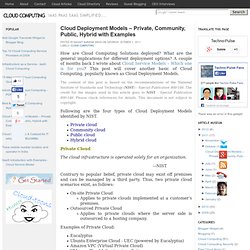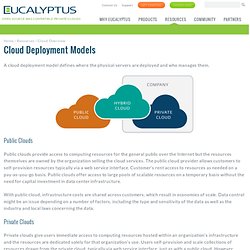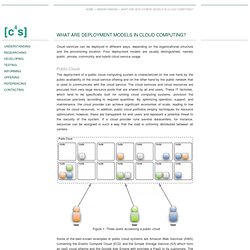

Cloud Deployment Models – Private, Community, Public, Hybrid with Examples. How are Cloud Computing Solutions deployed?

What are the general implications for different deployment options? A couple of months back I wrote about Cloud Service Models – Which one is for you? This post will cover another basic of Cloud Computing, popularly known as Cloud Deployment Models. The content of this post is based on the recommendations of the National Institute of Standards and Technology (NIST) - Special Publication 800-146. The credit for the images used in this article goes to NIST - Special Publication 800-146. Following are the four types of Cloud Deployment Models identified by NIST. Private cloud Community cloud Public cloud Hybrid cloud Private Cloud The cloud infrastructure is operated solely for an organization. Contrary to popular belief, private cloud may exist off premises and can be managed by a third party. On-site Private Cloud Applies to private clouds implemented at a customer’s premises.
OpenStack Basics - Overview. Build AWS-compatible Private Clouds with Eucalyptus. A cloud deployment model defines where the physical servers are deployed and who manages them.

Public Clouds Public clouds provide access to computing resources for the general public over the Internet but the resources themselves are owned by the organization selling the cloud services. The public cloud provider allows customers to self-provision resources typically via a web service interface. Customer's rent access to resources as needed on a pay-as-you-go basis. Public clouds offer access to large pools of scalable resources on a temporary basis without the need for capital investment in data center infrastructure.
With public cloud, infrastructure costs are shared across customers, which result in economies of scale. Private Clouds Private clouds give users immediate access to computing resources hosted within an organization's infrastructure and the resources are dedicated solely for that organization's use. Hybrid Clouds. Cloud computing. Cloud computing metaphor: For a user, the network elements representing the provider-rendered services are invisible, as if obscured by a cloud.

Cloud computing is a computing term or metaphor that evolved in the late 1990s, based on utility and consumption of computer resources. Cloud computing involves application systems which are executed within the cloud and operated through internet enabled devices. Purely cloud computing does not rely on the use of cloud storage as it will be removed upon users download action. Clouds can be classified as public, private and hybrid.[1][2] Overview[edit] Cloud computing[3] relies on sharing of resources to achieve coherence and economies of scale, similar to a utility (like the electricity grid) over a network.[2] At the foundation of cloud computing is the broader concept of converged infrastructure and shared services. Cloud computing, or in simpler shorthand just "the cloud", also focuses on maximizing the effectiveness of the shared resources. What are the Deployment Models? Cloud Deployment Methods. What are Deployment Models in Cloud Computing? - Cloud Computing Competence Center for Security.
Cloud services can be deployed in different ways, depending on the organizational structure and the provisioning location.

Four deployment models are usually distinguished, namely public, private, community and hybrid cloud service usage. Public Cloud The deployment of a public cloud computing system is characterized on the one hand by the public availability of the cloud service offering and on the other hand by the public network that is used to communicate with the cloud service. The cloud services and cloud resources are procured from very large resource pools that are shared by all end users. These IT factories, which tend to be specifically built for running cloud computing systems, provision the resources precisely according to required quantities.
Figure 1: Three users accessing a public cloud Private Cloud Private cloud computing systems emulate public cloud service offerings within an organization’s boundaries to make services accessible for one designated organization.